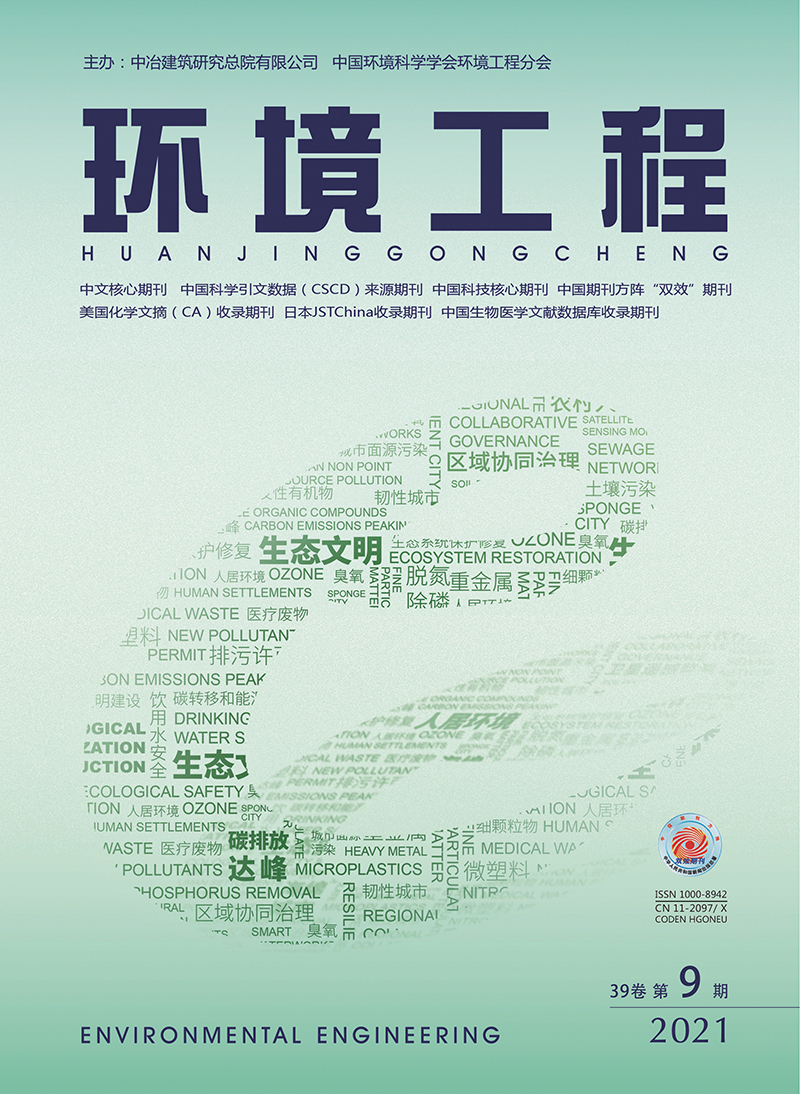| [1] |
ZHOU M M,YAN B H,WONG J W C,et al.Enhanced volatile fatty acids production from anaerobic fermentation of food waste:a mini-review focusing on acidogenic metabolic pathways[J].Bioresource Technology,2018,248:68-78.
|
| [2] |
夏旻,毕珠洁,张瑞娜,等.上海市餐厨垃圾理化特性及资源化预处理对策研究[J].环境卫生工程,2013,21(6):1-2.
|
| [3] |
YAN B H,SELVAM A,WONG J W C.Application of rumen microbes to enhance food waste hydrolysis in acidogenic leach-bed reactors[J].Bioresource Technology,2014,168:64-71.
|
| [4] |
SHEN F,YUAN H R,PANG Y Z,et al.Performances of anaerobic co-digestion of fruit & vegetable waste (FVW) and food waste (FW):single-phase vs.two-phase[J].Bioresource Technology,2013,144:80-85.
|
| [5] |
ABREU A A,TAVARES F,ALVES M M,et al.Garden and food waste co-fermentation for biohydrogen and biomethane production in a two-step hyperthermophilic-mesophilic process[J].Bioresource Technology,2019,278:180-186.
|
| [6] |
OLESKOWICZ-POPIEL P,KADAR Z,HEISKE S,et al.Co-production of ethanol,biogas,protein fodder and natural fertilizer in organic farming:evaluation of a concept for a farm-scale biorefinery[J].Bioresource Technology,2012,104:440-446.
|
| [7] |
FEI Q,FU R Z,SHANG L A,et al.Lipid production by microalgae Chlorella protothecoides with volatile fatty acids (VFAs) as carbon sources in heterotrophic cultivation and its economic assessment[J].Bioprocess and Biosystems Engineering,2015,38(4):691-700.
|
| [8] |
ZHENG J,GAO M,WANG Q H,et al.Enhancement of L-lactic acid production via synergism in open co-fermentation of Sophora flavescens residues and food waste[J].Bioresource Technology,2017,225:159-164.
|
| [9] |
WU Q L,BAO X,GUO W Q,et al.Medium chain carboxylic acids production from waste biomass:current advances and perspectives[J].Biotechnology Advances,2019,37(5):599-615.
|
| [10] |
ZHAO J W,ZHANG C,WANG D B,et al.Revealing the underlying mechanisms of how sodium chloride affects short-chain fatty acid production from the co-fermentation of waste activated sludge and food waste[J].Acs Sustainable Chemistry & Engineering,2016,4(9):4675-4684.
|
| [11] |
COOK S M,SKERLOS S J,RASKIN L,et al.A stability assessment tool for anaerobic co-digestion[J].Water Research,2017,112:19-28.
|
| [12] |
CHEN Y G,LUO J Y,YAN Y Y,et al.Enhanced production of short-chain fatty acid by co-fermentation of waste activated sludge and kitchen waste under alkaline conditions and its application to microbial fuel cells[J].Applied Energy,2013,102(S1):1197-1204.
|
| [13] |
WU S L,SUN J,CHEN X M,et al.Unveiling the mechanisms of medium-chain fatty acid production from waste activated sludge alkaline fermentation liquor through physiological,thermodynamic and metagenomic investigations[J].Water Research,2020,169:1-12.
|
| [14] |
ZHU X Y,TAO Y,LIANG C,et al.The synthesis of n-caproate from lactate:a new efficient process for medium-chain carboxylates production[J].Scientific Reports,2015,5:14360.
|
| [15] |
CARVAJAL-ARROYO J M,CANDRY P,ANDERSEN S J,et al.Granular fermentation enables high rate caproic acid production from solid-free thin stillage[J].Green Chemistry,2019,21(6):1330-1339.
|
| [16] |
YU J N,HUANG Z X,WU P,et al.Performance and microbial characterization of two-stage caproate fermentation from fruit and vegetable waste via anaerobic microbial consortia[J].Bioresource Technology,2019,284:398-405.
|
| [17] |
GILDEMYN S,MOLITOR B,USACK J G,et al.Upgrading syngas fermentation effluent using Clostridium kluyveri in a continuous fermentation[J].Biotechnology for Biofuels,2017,10:1-15.
|
| [18] |
TAO Y,ZHU X Y,WANG H,et al.Complete genome sequence of Ruminococcaceae bacterium CPB6:a newly isolated culture for efficient n-caproic acid production from lactate[J].Journal of Biotechnology,2017,259:91-94.
|
| [19] |
LOWRY O H,ROSEBROUGH N J,FARR A L,et al.Protein measurement with the Folin phenol reagent[J].The Journal of biological chemistry,1951,193(1):265-275.
|
| [20] |
GOEL R,MINO T,SATOH H,et al.Enzyme activities under anaerobic and aerobic conditions inactivated sludge sequencing batch reactor[J].Water Research,1998,32(7):2081-2088.
|
| [21] |
MU H,CHEN Y G.Long-term effect of ZnO nanoparticles on waste activated sludge anaerobic digestion[J].Water Research,2011,45(17):5612-5620.
|
| [22] |
XU X B,ZHANG W J,GU X,et al.Stabilizing lactate production through repeated batch fermentation of food waste and waste activated sludge[J].Bioresource Technology,2020,300:122709.
|
| [23] |
NYBROE O,JORGENSEN P E,HENZE M.Enzyme-activities in waste-water and activated-sludge[J].Water Research,1992,26(5):579-584.
|
| [24] |
ZHANG D P,SPADARO D,VALENTE S,et al.Cloning,characterization,expression and antifungal activity of an alkaline serine protease of Aureobasidium pullulans PL5 involved in the biological control of postharvest pathogens[J].International Journal of Food Microbiology,2012,153(3):453-464.
|
| [25] |
LIANG S,GLINIEWICZ K,MENDES-SOARES H,et al.Comparative analysis of microbial community of novel lactic acid fermentation inoculated with different undefined mixed cultures[J].Bioresource Technology,2015,179:268-274.
|
| [26] |
REDCORN R,ENGELBERTH A S.Identifying conditions to optimize lactic acid production from food waste co-digested with primary sludge[J].Biochemical Engineering Journal,2016,105:205-213.
|
| [27] |
ANGENENT L T,RICHTER H,BUCKEL W,et al.Chain elongation with reactor microbiomes:open-culture biotechnology to produce biochemicals[J].Environmental Science & Technology,2016,50(6):2796-2810.
|
| [28] |
ZHANG W J,LI X,ZHANG T,et al.High-rate lactic acid production from food waste and waste activated sludge via interactive control of pH adjustment and fermentation temperature[J].Chemical Engineering Journal,2017,328:197-206.
|
| [29] |
TASHIRO Y,KANEKO W,SUN Y Q,et al.Continuous D-lactic acid production by a novel thermotolerant Lactobacillus delbrueckii subsp lactis QU 41[J].Applied Microbiology And Biotechnology,2011,89(6):1741-1750.
|
| [30] |
BI D X,CHU D Q,ZHU P,et al.Utilization of dry distiller's grain and solubles as nutrient supplement in the simultaneous saccharification and ethanol fermentation at high solids loading of corn stover[J].Biotechnology Letters,2011,33(2):273-276.
|
| [31] |
COMA M,VILCHEZ-VARGAS R,ROUME H,et al.Product diversity linked to substrate usage in chain elongation by mixed-culture fermentation[J].Environmental Science & Technology,2016,50(12):6467-6476.
|
| [32] |
KUCEK L A,NGUYEN M,ANGENENT L T.Conversion of L-lactate into n-caproate by a continuously fed reactor microbiome[J].Water Research,2016,93:163-171.
|
| [33] |
TARASOV A L,BORZENKOV I A,BELYAYEV S S.Investigation of the trophic relations between anaerobic microorganisms from an underground gas repository during methanol utilization[J].Microbiology,2011,80(2):180-187.
|
| [34] |
CHEN Y,JIANG X,XIAO K,et al.Enhanced volatile fatty acids (VFAs) production in a thermophilic fermenter with stepwise pH increase:investigation on dissolved organic matter transformation and microbial community shift[J].Water Research,2017,112:261-268.
|
| [35] |
AGLER M T,SPIRITO C M,USACK J G,et al.Chain elongation with reactor microbiomes:upgrading dilute ethanol to medium-chain carboxylates[J].Energy & Environmental Science,2012,5(8):8189-8192.
|
| [36] |
KIM B C,SEUNG JEON B,KIM S,et al.Caproiciproducens galactitolivorans gen.nov.,sp.nov.,a bacterium capable of producing caproic acid from galactitol,isolated from a wastewater treatment plant[J].International Journal of Systematic and Evolutionary Microbiology,2015,65(12):4902-4908.
|
| [37] |
AGLER M T,WERNER J J,ITEN L B,et al.Shaping reactor microbiomes to produce the fuel precursorn-butyrate from pretreated cellulosic hydrolysates[J].Environmental Science & Technology,2012,46(18):10229-10238.
|
| [38] |
KHOR W C,ANDERSEN S,VERVAEREN H,et al.Electricity-assisted production of caproic acid from grass[J].Biotechnol Biofuels,2017,10(1):180-191.
|


 Login
Login Register
Register E-alert
E-alert






 DownLoad:
DownLoad: